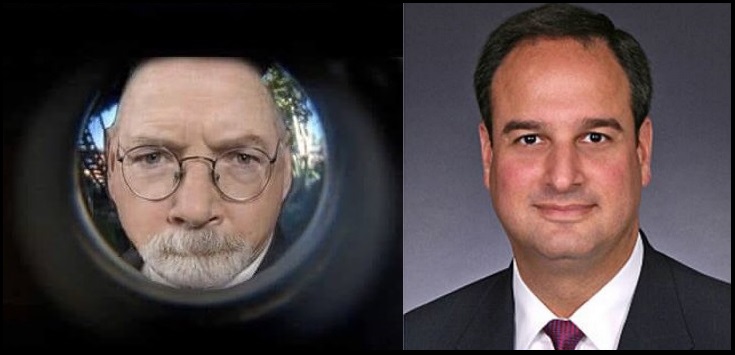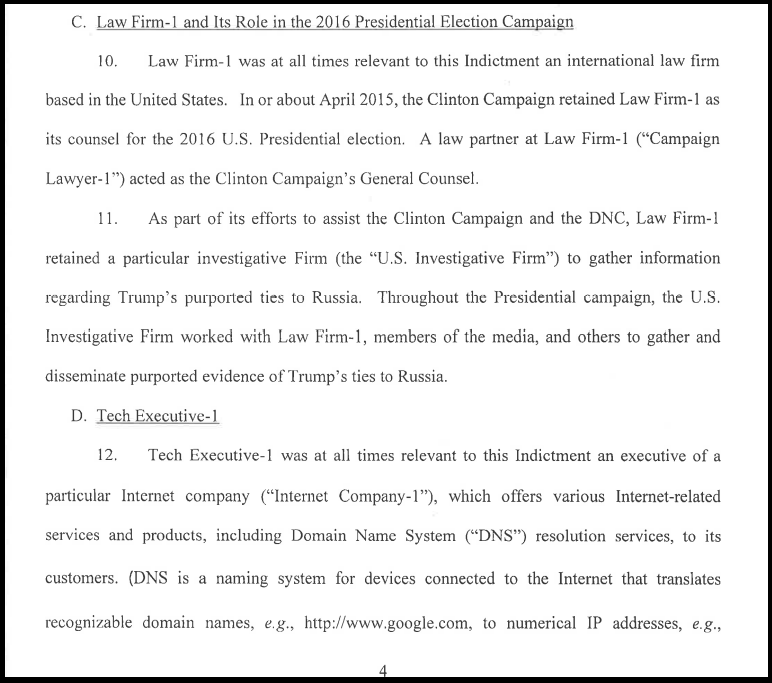U.S. Special Counsel John Durham has released an indictment [pdf here] of Perkins Coie lawyer Michael Sussmann for lying to federal investigators in 2016 about the people and motives behind his FBI contact. He failed to tell them his intent was to spread a false Alfa Bank conspiracy theory on behalf of the Clinton campaign.

Working for the Perkins Coie law firm, while under contract with Hillary Clinton’s campaign, partner Michael Sussmann contacted FBI Legal Counsel James Baker to pitch evidence that a Russian bank was in digital communications with servers in Trump Tower. The Alfa Bank allegation was one of the key components for the ridiculous Trump-Russia narrative put together by the Hillary Clinton campaign. Sussmann wanted the FBI to investigate Donald Trump, so that Hillary Clinton could push a political fabrication about Donald Trump working with Russians to steal the presidential election.
According to the indictment, Sussmann failed to tell the FBI that he was giving them this information on behalf of the Clinton campaign. The FBI investigated the claims and found nothing; however, it was the appearance of the investigation that Clinton needed in order to leak/push the Trump-Russia story to the media and stir up the controversy. There had to be something to the “Trump-Russia” story, because the FBI was investigating it. That fabricated smear served its intended purpose, and the media ran with it.

With the indictment now public, The New York Times also now admits Michael Sussmann was their source for stories they wrote about Alfa bank:
New York Times – […] In early September, the indictment said, Mr. Sussmann met with a New York Times reporter who would later draft a story about Alfa Bank, and also began work on a so-called white paper that would summarize and explain the researchers’ data and analysis, billing the time to the Clinton campaign.
On Sept. 12, the indictment said, Mr. Sussmann called Mr. Elias, the Clinton campaign lawyer, and spoke about his “efforts to communicate” with the Times reporter about the Alfa Bank allegations. Both billed the call to the campaign. And three days later, Mr. Elias exchanged emails with top campaign officials about the matter. (read more)
[…] Mr. Sussmann also continued to push the Alfa Bank story to reporters. A month before the election, as Times editors were weighing whether to publish an article the reporter had drafted, Mr. Sussmann told him he should show the editors an opinion essay saying the paper’s investigative reporters had not published as many stories regarding Mr. Trump as other media outlets, the indictment said. (read more)

Perkins Coie is “law firm-1”. Mark Elias is “campaign lawyer 1”. The “US Investigative Firm” is Fusion GPS. “Tech Executive-1” is likely Shawn Henry of Crowdstrike, although there are other possibilities.
In March 2016, Fusion GPS approached Perkins Coie to discuss potential engagement in the development of opposition research on Donald Trump, fully aware that Perkins Coie represented both the Democratic National Committee and the Clinton campaign.
In April 2016, Perkins Coie retained Fusion GPS on behalf of the Clinton campaign and the Democratic National Committee. Towards the end of the month, on April 29, Perkins Coie partner Michael Sussmann contacted Shawn Henry of CrowdStrike Services to hire the organization for the Democratic National Committee after a series of phishing e-mails started to affect their employees.
Before June 14, 2016, Sussmann, CrowdStrike Services and the Democratic National Committee carefully crafted a damage control story with regards to the hacking of the Democratic National Committee, which Dmitri Alperovitch and Shawn Henry released to Ellen Nakashima at The Washington Post.
On June 14, 2016, Nakashima, with contributions from Tom Hamburger, published the article “Russian government hackers penetrated DNC, stole opposition research on Trump” in The Washington Post.
After the article’s publishing, a number of bipartisan computer scientists — which included “John McCain Republicans” — started to search for Russian infiltrators. The members of the group were scattered across America and were numerous (there were at least nine members). To search for the infiltrators, they used the Domain Name System (DNS).
In late July 2016, a member of the bipartisan computer scientist organisation, known by the alias “Tea Leaves”, discovered potential malware moving from the Alfa Bank server to the Trump Organization server. The information “Tea Leaves” discovered was then circulated among his colleagues.
“Tea Leaves himself told The Intercept that he had to keep his identity and methods a secret because, ‘I run a cybersecurity company and I do not want DDOS and never have we been DDOS, nor do I want other attention.’” — The Intercept
“I also spoke with academics who vouched for Tea Leaves’ integrity and his unusual access to information. ‘This is someone I know well and is very well-known in the networking community,’ said Camp. ‘When they say something about DNS, you believe them. This person has technical authority and access to data.’” — Franklin Foer, Slate
October 31, 2016, Franklin Foer published the article, “Was a Trump Server Communicating With Russia?”, in Slate. This article was then retweeted by Hillary Clinton in a tweet which read: “It’s time for Trump to answer serious questions about his ties to Russia.”
This was soon followed by a statement from Jake Sullivan, tweeted through Hillary Clinton’s account: “Computer scientists have apparently uncovered a covert server linking the Trump Organization to a Russian-based bank.”
At the same time, days before Election Day 2016, the Clinton campaign and the Democratic National Committee ceased funding Fusion GPS’s research. Fusion GPS then passed Steele’s reports to Marc Elias at Perkins Coie.
The rest, as they say, is history….
